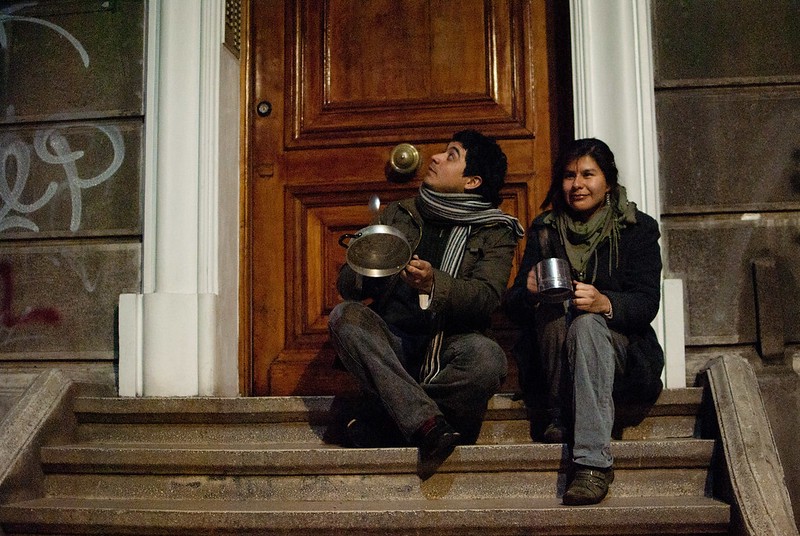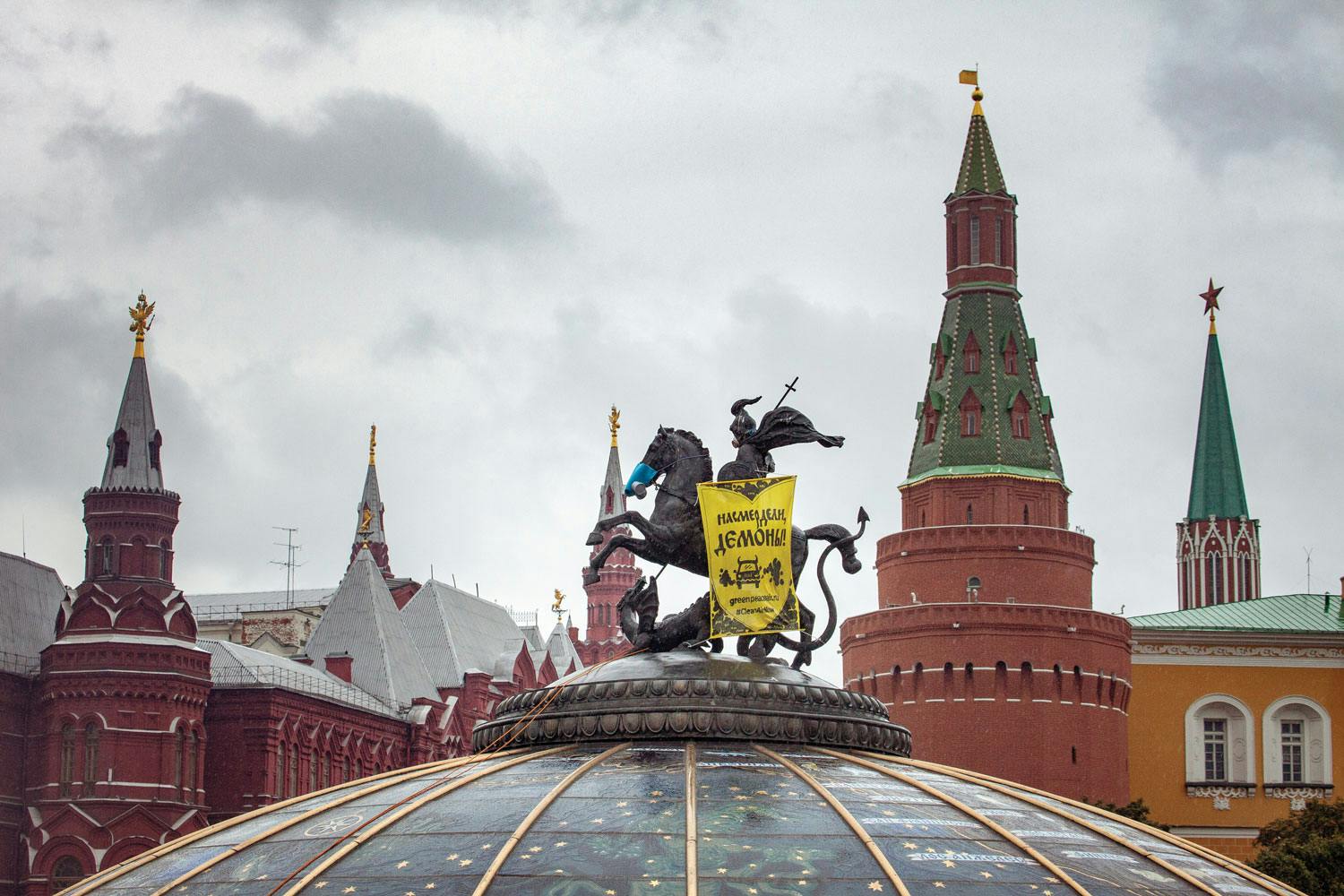What Does Protest Look Like When You Can’t Gather?
From Covid-19 lockdowns to Putin’s Russia, activists find ways to have impact despite restrictive conditions.
Russian Greenpeace activists outfitted this Moscow statue of St. George and his horse with respirators and a banner to protest air pollution.
With disaster comes disruption. Old rules no longer apply, and once-impassible avenues can suddenly open up. This is the situation many climate activists found ourselves in as the Covid-19 pandemic escalated.
On one hand, we were forced to adjust to new rules limiting our civil liberties — particularly freedom of assembly. Public health measures requiring social distancing meant rallies, marches, and sit-ins were suddenly off-limits for we-didn’t-know-how-long. On the other hand, we saw a powerful moment of disruption emerging, as people decried an economic system that left many workers without a safety net when disaster struck.
But how can you leverage disruption when you can’t — as the Avengers would put it — assemble? Looking back over those months, the answer for many activist groups was a nimble pivot to digital organizing.
Video-conferencing replaced city streets as youth climate strikers cancelled in-person marches and opted instead for nationally coordinated #DigitalStrikes. Hundreds of people logged on to the Vancouver-based strike over Zoom, cheering along as student emcees and guest speakers called for governments to financially support people, not the oil and gas industry. The virtual crowd posted selfies with their climate march signs (tagging Prime Minister Justin Trudeau, of course), and joined call-and-response chants (“When I say ‘people’, you say ‘power’!”), their enthusiasm undented by laggy connections.
Video-conferencing replaced city streets as youth climate strikers cancelled in-person marches and opted for #DigitalStrikes.
Meanwhile, youth in the UK led a “digital blockade” of the Coastal GasLink fracked gas pipeline half a world away in northern BC, flooding the communications channels of the project’s biggest potential investor.
Greenpeace Canada (where I work) adopted similar tactics. We caused a Twitterstorm when we asked our supporters to pepper federal cabinet ministers with tweets calling for a green and equitable recovery from Covid-19, not a bailout for Big Oil. To drive the message home, we hosted a phone-a-thon in which staff and volunteers came together digitally to call Members of Parliament. Phone-a-thon organizers provided instructions and moral support over video conference before everyone made calls on their own phones, then came back together to debrief.
Online campaigns like this can successfully channel our collective power, even from home. Case in point: since March, Canada’s oil industry has lobbied for billions of dollars in unrestricted bailouts and a full stop on climate action. But instead of granting Big Oil’s wishlist, the federal government imposed climate-related conditions on industry support, and focused funds on getting the sector to clean up abandoned oil wells and methane leaks.
Initial wins like this are inspiring, but I also wondered about the limits to an all-digital strategy. I explored the topic with digital-divide researcher Jen Schradie, a professor at Paris’ Sciences Po university, and author of The Revolution That Wasn’t: How Digital Activism Favors Conservatives.
The inequalities of real life are reproduced online.
“A large majority of people, at least all around the Global North, have skills to use the internet,” she said in our interview. “But there is a persistent class-based inequality where [some] folks don’t have consistent internet access or the digital tools to be able to participate online as [easily as] people who have a smartphone or laptops.” In other words, the inequalities of real life are reproduced online.
“My concern,” Shradie worried, “is — under this worldwide pandemic — that activism in general is going to be even more privileging the elite like never before.” She advises advocacy groups to designate someone in their organization to think through digital inequalities, and to understand who is taking action online, and how. Inclusion, says Shradie, should be a priority for any organization concerned about mass mobilization and building equity.

Cacerolazos don’t require a gathering, and have have long been a part of Latin American activism. These Chileans were photographed protesting on a Santiago stoop in 2011.
It’s also good to remember that activism without assembly doesn’t have to be online. Activists around the world have shown us this for decades. Back in 2003, Liberian women like Leymah Gbowee led a sex strike that helped end the country’s civil war. More recently, Chilean activists refused to let the coronavirus extinguish protests against the rising cost of living and privatization of pensions and water services. House-bound activists organized cacerolazos (pot-and-pan-banging protests on balconies) to keep the struggle alive. People around the world have taken a page out of Chileans’ book, using pots-and-pans noisemaking to show support for health care workers on the frontlines of the pandemic.
Today, in the Democratic Republic of the Congo — where civic space is rated as “closed” by civil society watchdogs — my colleagues at Greenpeace Africa continue to campaign to protect the Congo Basin Forest (the world’s second-largest rainforest) from harmful logging. It’s courageous work that requires careful consideration of when and how to speak out against powerful people. And sometimes requires precautions like going into hiding or changing phone numbers, according to Irene Wabiwa Betoko, who leads Greenpeace’s forest campaign in the region.
Keeping people engaged and hopeful is the most challenging aspect of the fight.
Speaking out as part of a coalition of groups, writing open letters, and leaking stories to journalists are just some tactics Kinshasa-based Betoko cites as ways to keep up the pressure while minimizing security risks. The hardest thing about her work? “Keeping people engaged and hopeful is the most challenging aspect of the fight,” Betoko wrote in an email. “The most important thing to do is to keep people, especially the ones directly impacted, informed on what is going on and give them a space to be part of the fight.”
One way Greenpeace Africa engages with impacted forest communities is by helping them secure legal rights to their own traditional territories. Sharing stories of positive change made by people in similar situations is another way to empower communities and keep hope alive, Betoko added.
Nurturing hope and maintaining motivation is also important in Russia, where silent one-person protests with a single banner are the only kind allowed without a permit under President Vladimir Putin. So, activists have evolved their strategies.
“People are inventing different tricks for how to make a single-person protest visible,” said Polina Malysheva — Greenpeace Russia’s Moscow-based program director — in an interview over Skype. “What Fridays for Future did, is have a line of people queuing up to protest with the banner.”
Humour, props, costumes, art installations — even dressing up statues — are among the tactics activists use to make an impact despite restrictions on freedom of assembly. But Malysheva believes the Fridays for Future climate strikers are Russia’s “hope for bringing activism to the next level.”
People are inventing different tricks for how to make a single-person protest visible.
“They are very digitally advanced and creative,” she said, enthusiasm radiating through the screen. The budding movement’s protests in Moscow over the past year have drawn just 20–30 youth but have already had a big impact. “They were invited by the Putin advisor on climate to have a talk. In an authoritarian state, it’s a very big deal to be an activist and be invited to speak to the top level of decision-makers.”
Activism under authoritarianism requires perseverance, especially when, as Malysheva says, much of the public may believe that protesting is “useless.”
“What is our recipe to fight this?” she mused, “It’s basically to support each other.”
Malysheva points to the morning-coffee video hangouts hosted by Russia’s climate strikers as one way activists are creating communities that stay inspired and offer solidarity. The number of people attending the calls has grown, she says, since many people are more comfortable taking steps into online action than agitating in the streets.
If the medium is the message, then the range of forms protest can take — and how it evolves under duress — is a powerful message of movements’ adaptability and tenacity.
I asked Malysheva what it’s like to be an activist when getting together in person is off-limits indefinitely. “People who are activists, they are born with it and carry it through their lives,” she said. “I think that being an activist in Russia is your destiny.”
Even lockdowns couldn’t contain the explosion of Black Lives Matter organizing this June.
Her answer sums up a spirit that I think applies across political regimes. It’s the same spirit we saw as even lockdowns couldn’t contain the explosion of Black Lives Matter organizing this June, when the rage and sorrow caused by racist oppression and police violence spilled into the streets in the form of thousands of mask-sporting activists. This is especially poignant as we collectively resurface from the initial onslaught of Covid-19, not sure if a second wave is coming.
One thing we do know is that from Canada to the Congo, from Russia to the US, there will always be people moved more by the desire for justice than they are deterred by the barriers to winning it.
Print Issue: Summer/Fall 2020
Print Title: Making Change When Getting Together is Off-limits
